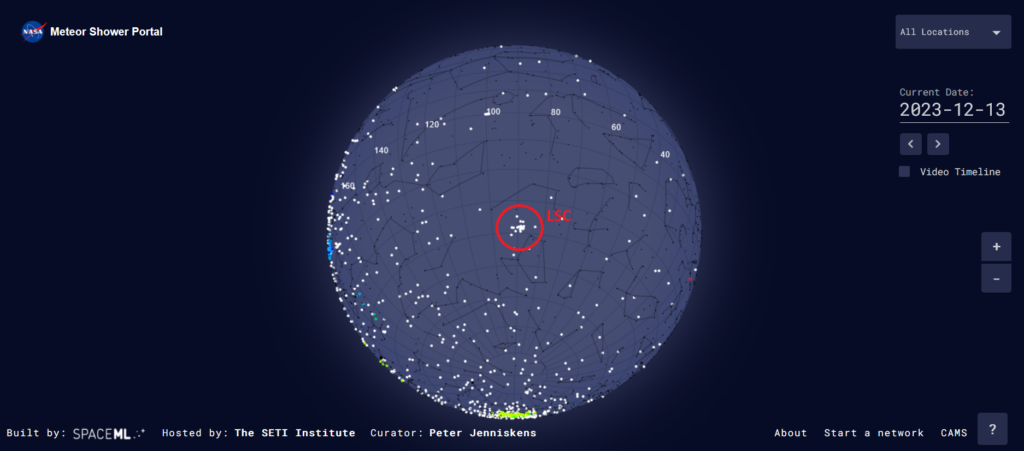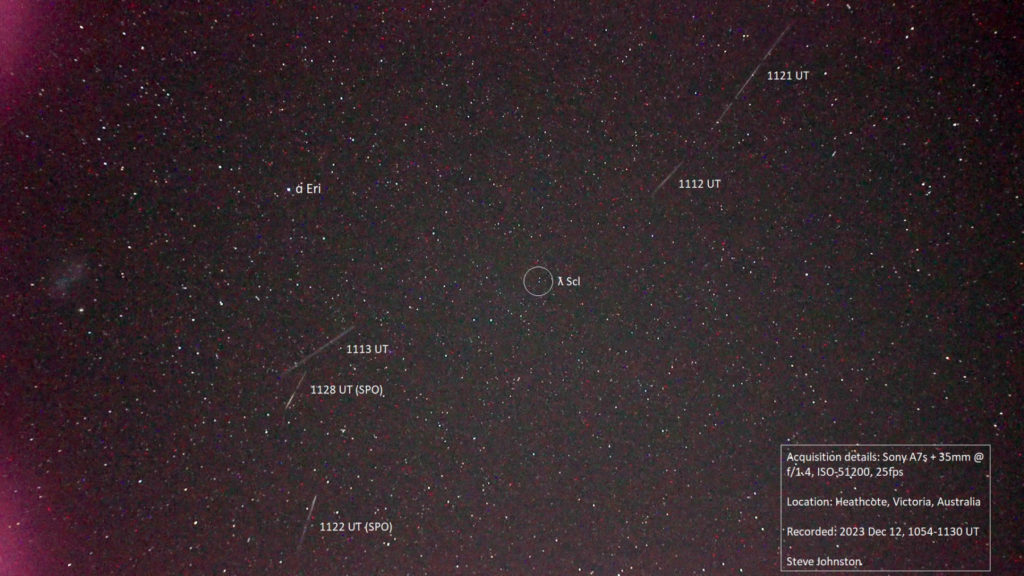On October 7, 2021, the activity of a new meteor shower, called Arids, associated to comet 15P/Finlay, was predicted by Jérémie Vaubaillon and his team from the Observatory of Paris and observed from Southern hemisphere, especially from Chile. On December 12, 2023, the same scenario occured, but it implies another comet: 46P/Wirtanen. According to the same team, an outburst associated to meteoroid released from the comet could be observed on December 12, 2023, between 09h30 and 11h40 UT, from a radiant located at R.A. = 7.3 to 9.2°, Decl. = -38.5 to -43.0°, with a velocity ranging from 9.8 to 10.3 km/s.

The new meteor shower was actually observed from the Southern hemisphere, close to the predicted time, by radio and video methods. According to CBET 5324 (see below), the activity of the new meteor shower was first detected in radio by H. Sugimoto, from December 12, 09h UT (sol. log. = 259.7°). It peaked around 13h UT (sol. log. = 259.9°), with an estimated equivalent visual ZHR of 120. CAMS Chile also detected a member of this new meteor shower and calculated radiant was R.A. = 4.6 +/- 0.5°, Decl. = -36.4 +/-0.9°, with a velocity of 8.6 +/- 0.1 km/s. From New-Zealand, 8 meteors originatong from the source could be triangulated by J. SCott (University of Otago) and Denis Vida (Global Meteor Network). The associated radiant was located at R.A. = 7.9 +/- 1.1°, Decl. = -38.8 +/-0.3°, with a velocity of 10.4 +/- 0.4 km/s (Figure 1).

Sources
- A new meteor shower caused by comet 46P/Wirtanen, IMMCE website
- Vaubaillon, J., Qhanzhi, Y., Egal, A., Sato, M., and Moser, D., 2023. A new meteor shower from comet 46P/Wirtanen expected in December 2023. A.Ap, in press.
- CBET 5324
Electronic Telegram No. 5324 Central Bureau for Astronomical Telegrams
Mailing address: Hoffman Lab 209; Harvard University;
20 Oxford St.; Cambridge, MA 02138; U.S.A.
e-mail:cbatiau@eps.harvard.edu (alternatecbat@iau.org)
URL http://www.cbat.eps.harvard.edu/index.html
Prepared using the Tamkin Foundation Computer Network
METEORS FROM COMET 46P/WIRTANEN
P. Jenniskens, SETI Institute and NASA Ames Research Center, reports that a predicted earth encounter with 1974 ejecta from comet 46P (cf. Vaubaillon et al. 2023, A.Ap, in press; website URL /https://arxiv.org/abs/2312.02636) was detected as a new meteor shower in the southern hemisphere on 2023 Dec. 12. Prior to this detection, comet 46P was not known as the parent body of a meteor shower. Vaubaillon et al. used several different dynamical models to predict a radiant near the stars lambda^1 and lambda^2 Scl with coordinates in the range R.A. = 7.3 to 9.2 deg, Decl. = -38.5 to -43.0 deg, and geocentric velocity 9.8 to 10.3 km/s, with a time of maximum expected in the range Dec. 12d09h to Dec. 13d06h UTC, with most models in the range Dec. 12d09h.5 to 11h.6 UTC. The proposed name for the new shower was lambda-Sculptorids (with code LSC). Leading up to the predicted peak, CAMS Chile detected a meteor from R.A. = 4.6 +/- 0.5 deg, Decl. = -36.4 +/- 0.9 deg, with geocentric velocity 8.6 +/- 0.1 km/s at solar longitude 259.402 deg (equinox J2000.0); corresponding orbital elements were a = 4.1 AU, q = 0.968 AU, e = 0.766, i = 7.6 deg, Peri. = 343.7 deg, and Node = 79.4 deg.
The first indication of a meteor outburst was reported by H. Sugimoto (cf. website URLhttps://www.iprmo.org/flash/gem-2023.html), who detected a sharp increase in radio forward meteor reflections from 41 stations starting at solar longitude 259.7 deg (Dec. 12d09h UTC). Rates peaked at solar longitude 259.9 deg (Dec. 12d13h UTC). For an assumed meteor-magnitude distribution index, the calculated equivalent peak visual zenith hourly rate (ZHR) was given as 120 meteors/hr. Subsequently, J. Scott (University of Otago, New Zealand), from calculations by D. Vida (Global Meteor Network), reported the detection of a cluster of 8 meteors from low-light video triangulations with a radiant centered on R.A. = 7.9 +/- 1.1, Decl. = -38.8 +/- 0.3 deg and geocentric velocity 10.2 +/- 0.4 km/s (standard error given) during the solar longitude interval 259.76-259.96 deg, centered on 259.86 +/- 0.02 deg (see map at website URLhttp://cams.seti.org/FDL/index-NZ.html for the date 2023 Dec. 13). Corresponding median orbital elements are a = 2.93 AU, q = 0.9846 +/- 0.0002 AU, e = 0.662 +/- 0.084, i = 9.6 +/- 0.9 deg, Peri. = 0.1 +/- 1.4 deg, Node = 79.89 +/- 0.07 deg (standard deviations given here). This confirms that the observed peak of radio forward reflections was due to the meteors of comet 46P, but the actual peak ZHR for a visual observer was likely lower.
NOTE: These ‘Central Bureau Electronic Telegrams’ are sometimes
superseded by text appearing later in the printed IAU Circulars.
(C) Copyright 2023 CBAT
2023 December 13 (CBET 5324) Daniel W. E. Green




 You saw something bright and fast? Like a huge shooting star? Report it: it may be a fireball.
You saw something bright and fast? Like a huge shooting star? Report it: it may be a fireball.  You counted meteors last night? Share your results with us!
You counted meteors last night? Share your results with us!  You took a photo of a meteor or fireball? You have a screenshot of your cam? Share it with us!
You took a photo of a meteor or fireball? You have a screenshot of your cam? Share it with us!  You caught a meteor or fireball on video? Share your video with us!
You caught a meteor or fireball on video? Share your video with us!